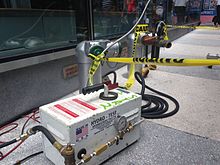A hydrostatic test is a way in which pressure vessels such as pipelines, plumbing, gas cylinders, boilers and fuel tanks can be tested for strength and leaks. The test involves filling the vessel or pipe system with a liquid, usually water, which may be dyed to aid in visual leak detection, and pressurization of the vessel to the specified test pressure. Pressure tightness can be tested by shutting off the supply valve and observing whether there is a pressure loss. The location of a leak can be visually identified more easily if the water contains a colorant. Strength is usually tested by measuring permanent deformation of the container. Hydrostatic testing is the most common method employed for testing pipes and pressure vessels. Using this test helps maintain safety standards and durability of a vessel over time. Newly manufactured pieces are initially qualified using the hydrostatic test. They are then re-qualified at regular intervals using the proof pressure test which is also called the modified hydrostatic test. Testing of pressure vessels for transport and storage of gases is very important because such containers can explode if they fail under pressure.
Hydrotesting of pipes, pipelines and vessels is performed to expose defective materials that have missed prior detection, ensure that any remaining defects are insignificant enough to allow operation at design pressures, expose possible leaks and serve as a final validation of the integrity of the constructed system. ASME B31.3 requires this testing to ensure tightness and strength.
Buried high pressure oil and gas pipelines are tested for strength by pressurizing them to at least 125% of their maximum allowable working pressure (MAWP) at any point along their length. Since many long distance transmission pipelines are designed to have a steel hoop stress of 80% of specified minimum yield strength (SMYS) at maximum allowable operating pressure (MAOP), this means that the steel is stressed to SMYS and above during the testing, and test sections must be selected to ensure that excessive plastic deformation does not occur.
Test pressures need not exceed a value that would produce a stress higher than yield stress at test temperature. ASME B31.3 section 345.4.2 (c)
Other codes require a more onerous approach. BS PD 8010-2 requires testing to 150% of the design pressure – which should not be less than the MAOP plus surge and other incidental effects that will occur during normal operation.
Leak testing is performed by balancing changes in the measured pressure in the test section against the theoretical pressure changes calculated from changes in the measured temperature of the test section.
Australian standard AS2885.5 “Pipelines—Gas and liquid petroleum: Part 5: Field pressure testing” gives an excellent explanation of the factors involved.

ASME B 31.8 specifies the test pressure factors for pipelines operating at hoop stress of 30% of SMYS. This code also limits the maximum hoop stress permitted during tests for various class locations if the test medium is air or gas. There are different factors associated with different pipeline class and division locations. For example, the hydrotest pressure for a class 3 or 4 location is 1.4 times the MOP. The magnitude of test pressure for class 1 division 1 gas pipeline transportation is usually limited to 125% of the design pressure, if the design pressure is known. The allowed stress in the pipe material is limited to 72% of SMYS. In some cases it is extended to 80% of SMYS. The position of Pipeline and Hazardous Material Safety Administration (PHMSA) is similar. Thus, a pipeline designed to operate continuously at 1,000 psig will be hydrostatically tested to a minimum pressure of 1,250 psig.
Sources :
No comments:
Post a Comment